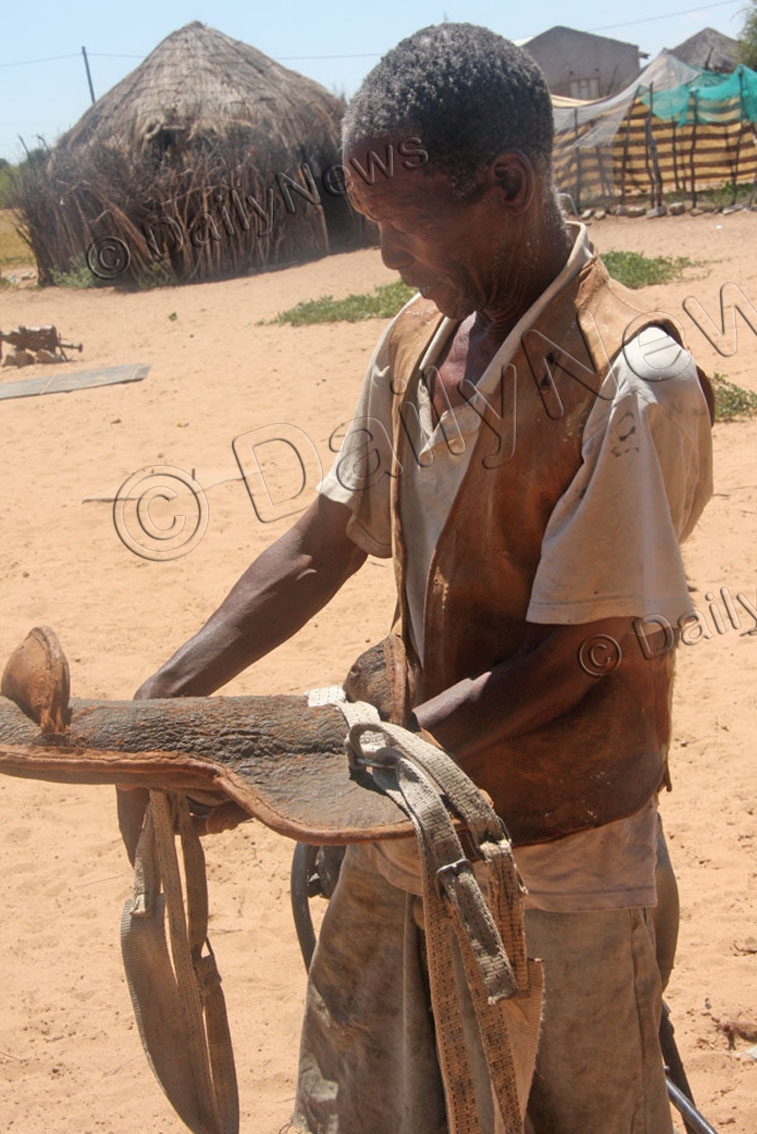Surviving desert with leather
29 Jun 2015
Batswana are said to have long acquired skill in leather processing.
However and despite the country being an epicentre of the cattle industry which has grown the economy through exports to Europe, development of the leather industry continues to lag behind.
This untapped potential which can help with economic diversification and contribute to economic growth, notwithstanding, continues to grow steadily.
Many Batswana are trained at the Rural Industries Innovation Centre (RIIC) in Kanye to nurture and sharpen their skills in different crafts including leather processing. However, many of them continue to struggle to penetrate the market due to either lack of capital or machinery to grow their businesses.
Unlike many, there are those passionate ones who continue to use traditional methods to make leather products. Besides, it helps them put food on the table.
In Dutlwe, Ntshekisang Tebogelo, popularly known as “Radiphate” in the village, continues to make a living from leather.
It is amazing how the 75-year-old, that at such an age, continues to defy the energy sapping process to work with leather.
When BOPA visited his workplace, Tebogelo said after a stint at the South African mines, he came back to Botswana where he joined his father at Mantshwabisi who was skilled in leather processing.
He says after a few months working with his father, he worked for a borehole drilling company after which he left and settled at Dutlwe where he carried on with his craft.
Tebogelo says he was prompted to act swiftly after he saw some people just throwing away skins.It was then that he decided to start working with leather, putting to good use the skills acquired from his father.
The talented and skilful Tebogelo says a certain whiteman whom he met while still a learner assisted him to enrol for training with RIIC in Kanye. He says the training imparted him with skills to work better with leather besides the different methods and designs for his products.
Tebogelo says working with leather is not as easy as “eating soft porridge”.
“One has to have determination to go through the process of preparing leather until the end product.”
He says notwithstanding the idiomatic expression that “it takes two to tango”, he would not have done it had he not met the whiteman and teachers who helped him sharpen his skills in leather processing.
Tebogelo says due to lack of machinery, he relies on traditional methods to make custom designs for his customers.
He soaks the leather in water mixed with “mositshane,” a tuberous plant of the beetroot family, to give the leather a reddish colour.
Tebogelo says it takes up to one and a half months to get the hides ready but they need to be turned over once in a while to make sure the traditional colourant does its work. Furthermore, he says for the skin to be workable, it has to be softened and water helps as a catalyst.
The craftsman says there is a chemical catalyst called mimosa which reduces the time to process the skin from one and half months to about two to three weeks.
He says the problem is that he cannot afford the chemical hence cannot continue using it.
A 25kg bag costs P600 which is too steep for him given the fact that he is not making enough profit from his products.
He says he makes sandals, hats, mats and ladies handbags. Most of his customers are women. Tebogelo says even though he has loyal customers he is struggling to penetrate the market.
However, he believes that participating in the presidential art competitions will be helpful as they provide a platform for advertising one’s products.
He says he will forever remain thankful to people who sometimes give him the skins for free.
Tebogelo says he has realised that some hides have weak fur which makes them not durable, adding that strong fur helps him make better leather products.
He adds that he has been working with traditional dance groups which have helped boost his business. He says they choose the colour they prefer and he gets work done without delay.
Tebogelo says he believes that if he could get the necessary machinery he will be able to work at ease and meet demand. He insists that some youth drag their feet when it comes to working with skins even after teaching them the craft.
“I have taught some people the skills but many of them are doing nothing at all,” says Tebogelo. He adds that he continues to work with RIIC so that he also contributes to training those who love working with leather.
He says the leather industry is not for the faint hearted because one has to endure the odour from skins. Ends
Source : BOPA
Author : Booster Mogapi
Location : Dutlwe
Event : Interview
Date : 29 Jun 2015







